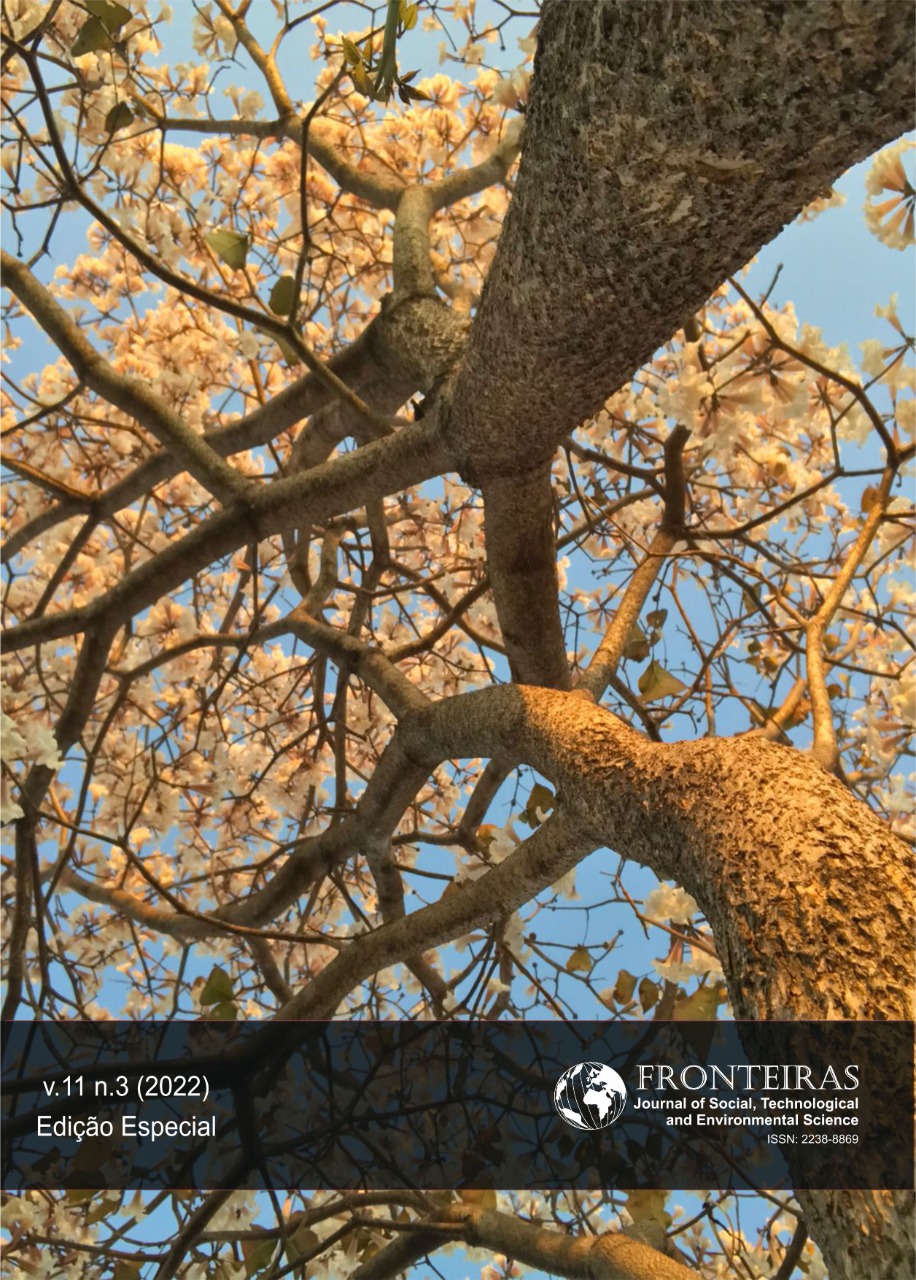Conflicts Between Neighbors: Viticulturists and Soybean Farmers at the Pampa Biome – RS, Brazil
DOI:
https://doi.org/10.21664/2238-8869.2022v11i3.p9-21Palavras-chave:
vineyards, transgenic soybean, environment, campanha gaúchaResumo
The Pampa Biome represented in last four centuries a specialization in cattle production, with high historical, socioeconomic, and cultural similarities between Argentina, Brazil, and Uruguay, the countries that share the same Biome. However, from the twentieth century onward the scenario changed. Agriculture and forestry, because of the higher and faster financial returns are now the most important in socio and economic levels. From 2000 onward, a movement of expansion in Brazilian viticulture has highlighted new potential borders, in this case, replacing natural pastures in the Pampa Biome. The significant growth of grapevine area can be illustrated by the doubled surface, reaching 1560 hectares, and the number of vineyards grew from 7 to more than a 100. In 2010 it was created the association “Vinhos da Campanha†to represent the region, to structure the geographical indication and to improve the visibility of this terroir and their physical and environmental conditions. However, viticulturists did not expect a huge threat to their vineyards. In the seven past years, the 2,4-D based herbicides spread over transgenic soybean plants cultivated nearby vineyards is causing the decrease of fruit production, presence of herbicide residue in harvested fruit, killing parts or even the entire vineyards: all damages representing monetary losses. Finally, due to the losses and the underway lawsuits, the community cohesion has been broken apart: viticulturists increased cohesion and union among themselves, but social cohesion between them and soybean growers no longer exist in several areas of Rio Grande do Sul state. Later on similar scenario reached other Brazilian States and other fruit species.
Referências
Dardeau, Rogerio. 2020. Gente, lugares e vinhos do Brasil. Rio de Janeiro: Mauad X.
Echer, Reges.; José Antônio Weycamp da Cruz; Carina Costa Estrela, Marcelo Moreira e Filipe Gravato. 2016. Usos da terra e ameaças para a conservação da biodiversidade no bioma Pampa, Rio Grande do Sul. Revista Thema: 4–13.
Falcade, Ivanira. A paisagem como representação espacial: a paisagem vitícola como símbolo das indicações de procedência de vinhos das regiões Vale dos Vinhedos, Pinto Bandeira e Monte Belo (Brasil). Tese de Doutorado em Geografia, Universidade Federal do Rio Grande do Sul.
Flores, Shana Sabbado. 2011. Desenvolvimento territorial sustentável a partir dos territórios do vinho: O caso dos “Vinhos da Campanha”. Master’s degree, UFRGS.
G1-RS. Uso do herbicida 2,4-D é suspenso até o fim do ano pela Secretaria da Agricultura do RS. https://g1.globo.com/rs/rio-grande-do-sul/noticia/2019/12/03/uso-do-herbicida-24-d-e-suspenso-ate-o-fim-do-ano-pela-secretaria-da-agricultura-do-rs.ghtml (Accessed June 12, 2020).
Gonçalves Terreri, Laianny, Julia Mai Velasco, e Eunice Nodari. 2022. Cultura E Tradição. Fronteiras: Revista Catarinense De História, nº 39 (janeiro), 30-49. https://doi.org/10.29327/253484.1.39-21
Melo, Liana. See #Colabora. Lesão, mutilação e morte nos vinhedos. https://projetocolabora.com.br/ods15/agrotoxico-24-d-mutila-e-mata-em-vinhedos-no-sul/ (Accessed April 2, 2022).
https://projetocolabora.com.br/ods15/agrotoxico-24-d-mutila-e-mata-em-vinhedos-no-sul/ (Accessed April 2, 2022).
Melo, Liana. See #Colabora. O veneno da soja contra os vinhos gaúchos. https://projetocolabora.com.br/ods15/vinhedo/ (Accessed 27 April 2022)
Ministério Público do Rio Grande do Sul. See MPRS. Reunião reforça recomendação expedida pela promotoria de Bagé e Nucam sobre o uso do agrotóxico 2.4-D. https://www.mprs.mp.br/noticias/48098/ (Accessed April 27, 2022).
Minuzzi, João Davi Oliveira e Débora Nunes de Sá. “Fronteiras Sul-Americanas: o Pampa e a Mata Atlântica sob a perspectiva da História Ambiental”, Fronteiras 39 (janeiro de 2022):195-212.
Miraglia, Marina, Juan Manuel Cerdá, Marianel Falconer, Eunice Sueli Nodari, e Juan Facundo Rojas. 2022. O Território E a Transformação Vitivinícola De Mendoza (Argentina) Desde a Perspectiva Das Mulheres. Fronteiras: Revista Catarinense De História, nº 39 (janeiro), 10-29. https://doi.org/10.29327/253484.1.39-20.
Nodari, Eunice Sueli e Zephyr Frank. 2019. Vinhos De Altitude No Estado De Santa Catarina: A firmação De Uma Identidade. Tempo E Argumento : 183 - 200.
Nodari, Eunice, and Marcos Gerhardt. 2021. “The Uruguay River: A Permeable Border in South America”. Review of International American Studies 14 (1), 201-27. https://doi.org/10.31261/rias.10047.
Pires Vieira da Rocha, Carla, y Eunice Sueli Nodari. 2020. Winemaking, Environmental Impacts and Sustainability: New Pathways from Vineyard to Glass?. Historia Ambiental Latinoamericana Y Caribeña (HALAC) Revista De La Solcha: 223-43. https://doi.org/10.32991/2237-2717.2020v10i1.p223-243.
Rollsing, Carlos. See GZH. Herbicida volta a causar atrofia em vinhedos e acirra crise entre produtores rurais. https://gauchazh.clicrbs.com.br/economia/campo-e-lavoura/noticia/2020/10/herbicida-volta-a-causar-atrofia-em-vinhedos-e-acirra-crise-entre-produtores-rurais-ckgw4jwu7000o015x9q76kai7.html (Accessed April 5, 2022).
Silveira, Samar Velho da e José Fernando da Silva Protas, ed. 2021. Vinhos finos da região da campanha gaúcha: tecnologias para a vitivinicultura e para estruturação de indicação geográficaBento Gonçalves, RS. Bento Gonçalves: Embrapa Uva e Vinho.
Vargas, L., M. A. Bianchi, M. A. Rizzardi, D. Agostinietto e D. Dal Magro. 2007. Conyza bonariensis biotypes resistant to the glyphosate in southern Brazil. Planta Daninha: 573-78.
Viana, João Garibaldi Almeida, Rafaela Vendruscolo, Vicente Celestino Pires Silveira, Fernando Luiz Ferreira de Quadros, Mariana Patricia Mezzomo e Jean Fraçois Tourrand. 2021. Sustainability of Livestock Systems in the Pampa Biome of Brazil: An Analysis Highlighting the Rangeland Dilemma. Sustainability 2021: 1-24.
Viscardi, Karen. See GZH. Casos de deriva do agrotóxico 2,4-D dobram em um ano no RS, com 140 laudos comprovados em 2019. https://gauchazh.clicrbs.com.br/colunistas/gisele-loeblein/noticia/2020/01/casos-de-deriva-do-agrotoxico-24-d-dobram-em-um-ano-no-rs-com-140-laudos-comprovados-em-2019-ck5rbbc7d0arq01mvlv7a2hd0.html (Accessed 27 April 2022).
Zarth, Paulo A. e Marcos Gerhardt. 2009. Uma história ambiental do pampa do Rio Grande do Sul. Em Lavouras de destruição: a (im)posição do consenso, coords. Althen Teixeira Filho. Pelotas: UFPEL, 2009.
Downloads
Publicado
Como Citar
Edição
Seção
Licença
Esta revista oferece acesso livre imediato ao seu conteúdo, seguindo o princípio de que disponibilizar gratuitamente o conhecimento científico ao público proporciona maior democratização mundial do conhecimento.
A partir da publicação realizada na revista os autores possuem copyright e direitos de publicação de seus artigos sem restrições.
A Revista Fronteiras: Journal of Social, Technological and Environmental Science segue os preceitos legais da licença Creative Commons - Atribuição-NãoComercial 4.0 Internacional. 

